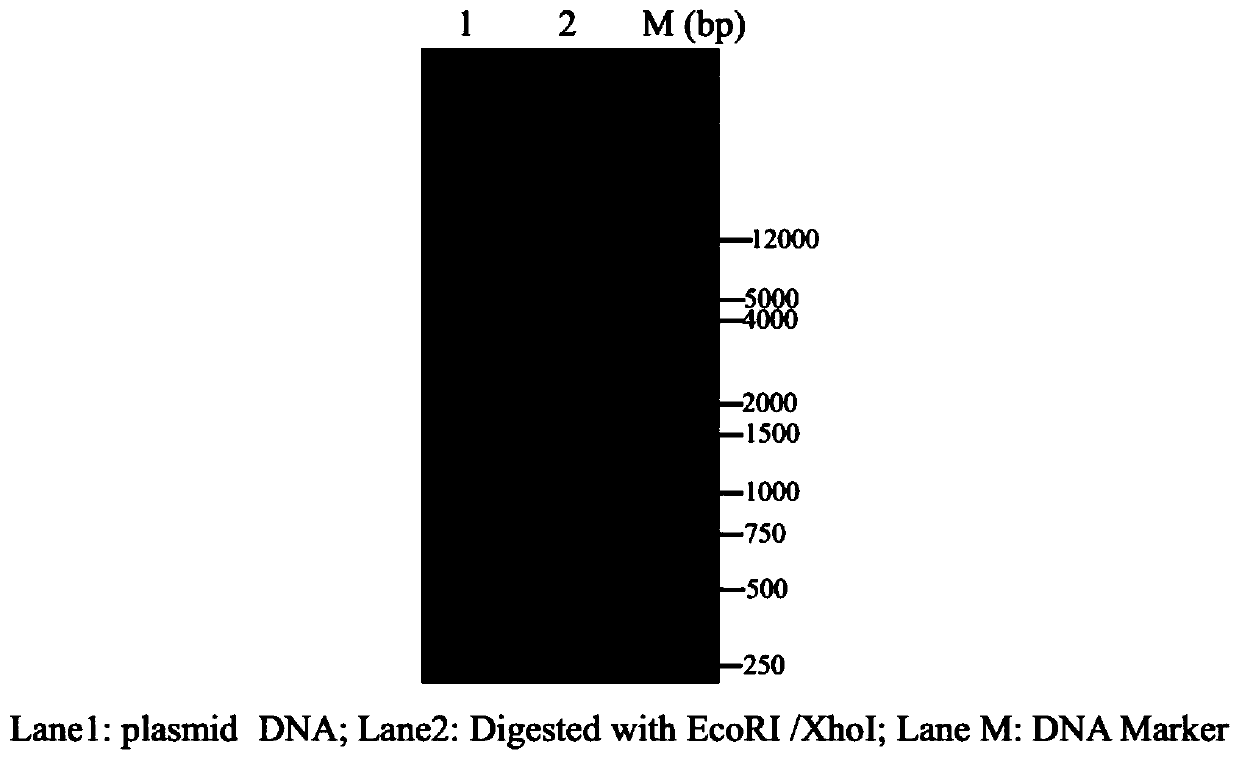Recombinant vector and expression method of tea tree heat shock protein CssHSP-6 gene
A heat shock protein and recombinant vector technology, applied in the biological field, can solve the problems of cumbersome steps and low success rate, and achieve the effect of improving disease resistance
- Summary
- Abstract
- Description
- Claims
- Application Information
AI Technical Summary
Problems solved by technology
Method used
Image
Examples
Embodiment 1
[0028] Example 1: Construction and Identification of Tea Tree Heat Shock Protein CssHSP-6 Gene Recombination Vector
[0029] 1. Extract RNA from tea tree leaves and reverse transcribe cDNA
[0030] Tea tree leaf materials were taken, and total RNA at the seedling stage was extracted with an RNA extraction kit (Tiangen Biochemical Technology (Beijing) Co., Ltd.), and cDNA was reverse-transcribed with a reverse transcription kit (Promega).
[0031] 2. Using cDNA as a template to amplify the CssHSP-6 gene;
[0032] Primers were designed to amplify the CssHSP-6 gene using cDNA as a template. The nucleotide sequence of the CssHSP-6 gene is shown in SEQ ID NO.1, and the amino acid sequence of the protein encoded by the CssHSP-6 gene is shown in SEQ ID NO. 2.
[0033] Primers are as follows:
[0034] Upstream primer: CssHSP-6-F: GC GAATTC The underline of ATGGCGATGATTCCAAG is the EcoRI restriction site;
[0035] Downstream primer: CssHSP-6-R: CG CTCGAG TCAACCAGATATCTCAATAGACTT...
Embodiment 2
[0042] Example 2: Induced expression of CssHSP-6 protein
[0043] 1. Obtain the recombinant prokaryotic expression strain of CssHSP-6
[0044] The single clone successfully sequenced in Example 1 was selected and inoculated into 50ug / mL kanamycin liquid medium, cultured overnight at 37°C and 200rpm, and the pET-28a - The CssHSP-6 recombinant expression vector was extracted, and the recombinant expression vector was transformed into Escherichia coli BL21(DE3), Rosetta(DE3), BL21(DE3)pLysS strains, and the expression of CssHSP-6 protein was detected.
[0045] 2. Cultivate the activated strain overnight
[0046] The above-mentioned recombinant prokaryotic expression strains were activated by culturing overnight. For example, transfer BL21(DE3) strains to 50ug / mL kanamycin liquid medium, transfer Rosetta(DE3), BL21(DE3)pLysS strains to 50ug / mL kanamycin+50ug / mL chlorine The activated strain was cultured overnight at 37°C and 200 rpm in a mycin liquid medium.
[0047] 3. Induced ...
Embodiment 3
[0055] Example 3: Verification of CssHSP-6 Protein Inducible Expression Conditions
[0056] 1. Obtain the recombinant expression strain of CssHSP-6
[0057] The single clone successfully sequenced in Example 1 was selected and inoculated into 50ug / mL kanamycin liquid medium, cultured overnight at 37°C and 200rpm, and the pET-28a - The CssHSP-6 recombinant expression vector was extracted, and the recombinant expression vector was transformed into Escherichia coli BL21 (DE3), Rosetta (DE3), BL21 (DE3) pLysS bacterial strain respectively, and coated on a plate containing 50ug / mL kanamycin (Rosetta ( DE3), BL21(DE3)pLysS strains need to be supplemented with 50ug / mL chloramphenicol) for overnight culture at 37°C, pick a single colony and inoculate it into the liquid medium containing the corresponding antibiotics, culture overnight at 37°C, 200rpm, Sterilized 50% glycerol was added to the bacterial solution, mixed evenly and then frozen in a -80°C refrigerator to obtain a prokaryo...
PUM
 Login to View More
Login to View More Abstract
Description
Claims
Application Information
 Login to View More
Login to View More - R&D
- Intellectual Property
- Life Sciences
- Materials
- Tech Scout
- Unparalleled Data Quality
- Higher Quality Content
- 60% Fewer Hallucinations
Browse by: Latest US Patents, China's latest patents, Technical Efficacy Thesaurus, Application Domain, Technology Topic, Popular Technical Reports.
© 2025 PatSnap. All rights reserved.Legal|Privacy policy|Modern Slavery Act Transparency Statement|Sitemap|About US| Contact US: help@patsnap.com



